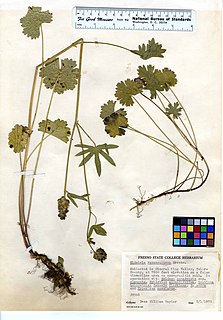
Gentianopsis holopetala is a species of flowering plant in the gentian family known by the common names Sierra fringed gentian or just "Sierra gentian"'. It is native to the Sierra Nevada and adjacent mountains in California and Nevada, in wet meadows from 6000 to 11,000 ft in elevation. This is an annual or perennial herb, growing stems which may be anywhere from a few centimeters long to nearly half a meter, and may lay along the ground or grow erect. Its small oval or spoon-shaped leaves are mostly basal but may grow sparsely further along the stem.

Hackelia californica is a species of flowering plant in the borage family known by the common name California stickseed.

Ivesia aperta is a species of flowering plant in the rose family known by the common name Sierra Valley mousetail.

Ivesia lycopodioides is a species of flowering plant in the rose family known by the common name clubmoss mousetail, or clubmoss ivesia. It is native to the Sierra Nevada and to regions east of the range in California. It may also be found beyond the state line into Nevada. This is a perennial herb which grows in the crevices of rock ledges in the mountains and in wet high-elevation meadows. It produces a rosette of flat to cylindrical leaves up to 15 centimeters long, each of which is made up of many tiny, lobed leaflets. The stems may grow erect or drooping to 30 centimeters long and each holds an inflorescence of clustered flowers. Each flower has hairy, greenish triangular sepals and much larger oval-shaped petals of bright yellow. In the center of the flower are usually five stamens and several pistils. There are three subspecies.

Antennaria corymbosa is a North American species of flowering plants in the daisy family known by the common name flat-top pussytoes or meadow pussytoes. It is native to western Canada and the Western United States south as far as Tulare County in California and Rio Arriba County in New Mexico. It grows in moist, cool areas such as mountain meadows and riverbanks. Most of the populations are found in the Rocky Mountains, the Cascades, and the Sierra Nevada.

Calochortus nudus is a North American species of flowering plant in the lily family known by the common name naked mariposa lily.
Epilobium howellii is an uncommon species of flowering plant in the evening primrose family known by the common names Yuba Pass willowherb and subalpine fireweed. It is endemic to the High Sierra Nevada of California, where it is known from only about 20 occurrences.
Leptosiphon oblanceolatus is a species of flowering plant in the phlox family known by the common name Sierra Nevada linanthus.
Lupinus grayi is a species of lupine known by the common name Sierra lupine. It is endemic to California, where its distribution extends the length of the Sierra Nevada and its foothills and includes the Tehachapi Mountains.
Kyhosia is a monotypic genus of flowering plants in the aster family containing the single species Kyhosia bolanderi, which is known by the common names Bolander's madia and kyhosia.
Orochaenactis is a monotypic genus of flowering plants in the daisy family containing the single species Orochaenactis thysanocarpha, which is known by the common name California mountain pincushion. It is endemic to the southern Sierra Nevada of California, where it grows in the forests and meadows of the high mountains.

Mitella breweri is a species of flowering plant in the saxifrage family known by the common names Brewer's mitrewort and Brewer's bishop's cap. It is native to western North America from British Columbia to central California and Nevada, where it grows in moist meadows, woods, and mountain forests. It is a rhizomatous perennial herb growing up to about 30 or 40 centimeters tall. Most of the leaves occur around the base of the stem. They have rounded blades several centimeters wide and edges divided into dull toothed lobes. The erect inflorescence bears several flowers, sometimes over 50, usually along one side of the stem. The distinctive flower is saucer-shaped with five greenish petals which are divided into narrow, whiskerlike lobes.

Mitella pentandra, or Pectiantia pentandra, is a species of flowering plant in the Saxifrage Family (Saxifragaceae), known by the common names fivestamen miterwort or five-point bishop's cap.
Monardella linoides is a species of flowering plant in the mint family known by the common name flaxleaf monardella.

Ranunculus eschscholtzii is a species of buttercup flower known by the common name Eschscholtz's buttercup.

Ribes roezlii is a North American species of currant known by the common name Sierra gooseberry.

Sidalcea ranunculacea is a species of flowering plant in the mallow family known by the common name marsh checkerbloom and marsh checker mallow.
Trifolium monanthum is a species of clover known by the common name mountain carpet clover.

Wyethia mollis is a species of flowering plant in the aster family known by the common name woolly mule's ears. The plant is hairy to woolly in texture, sometimes losing its hairs with age.

The flora of the U.S. Sierra Nevada alpine zone is characterized by small, low growing, cushion and mat forming plants that can survive the harsh conditions in the high-altitude alpine zone above the timber line. These flora often occur in alpine fell-fields. The Sierra Nevada alpine zone lacks a dominant plant species that characterizes it, so may or may not be called a vegetation type. But it is found above the subalpine forest, which is the highest in a succession of recognized vegetation types at increasing elevations.














